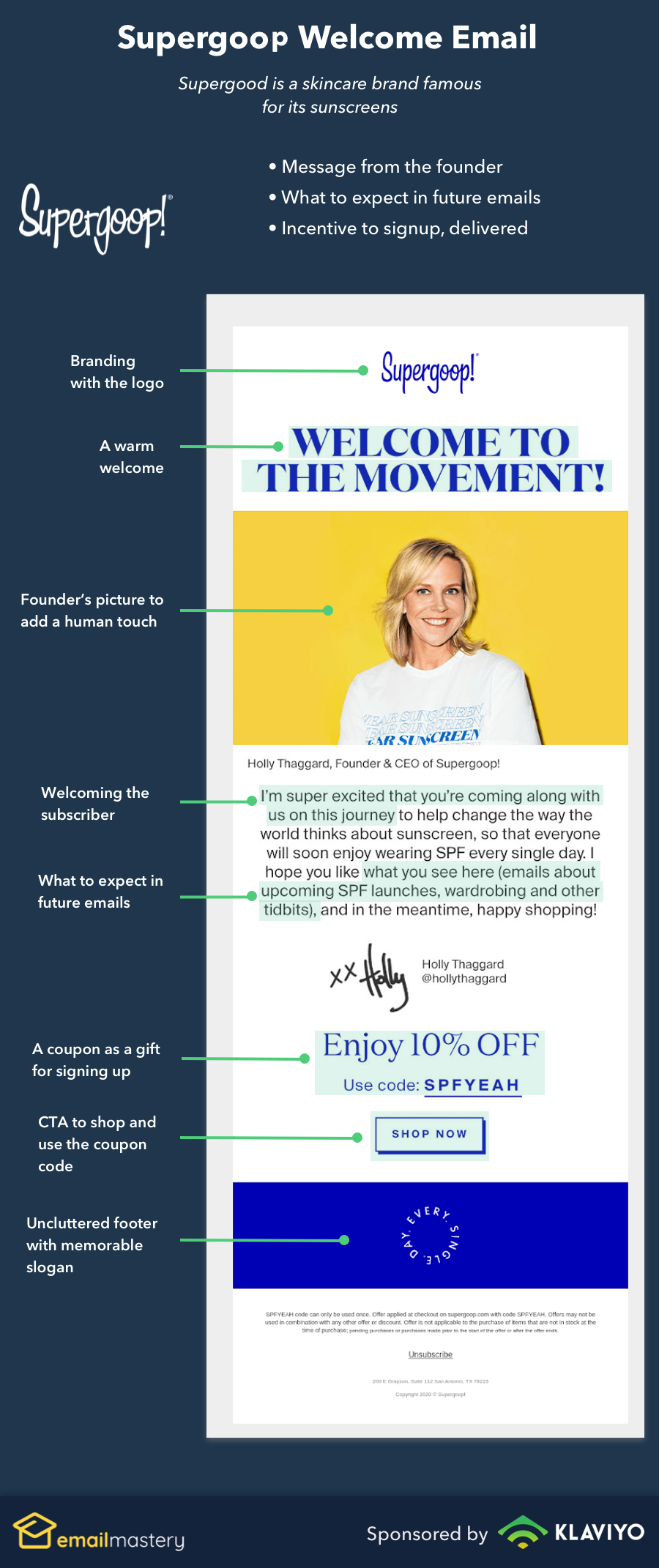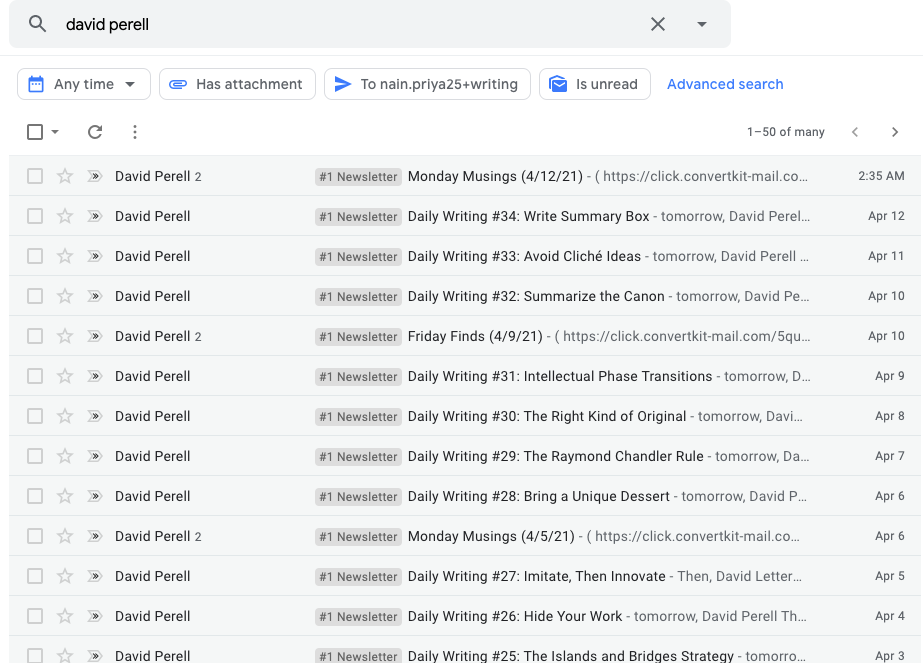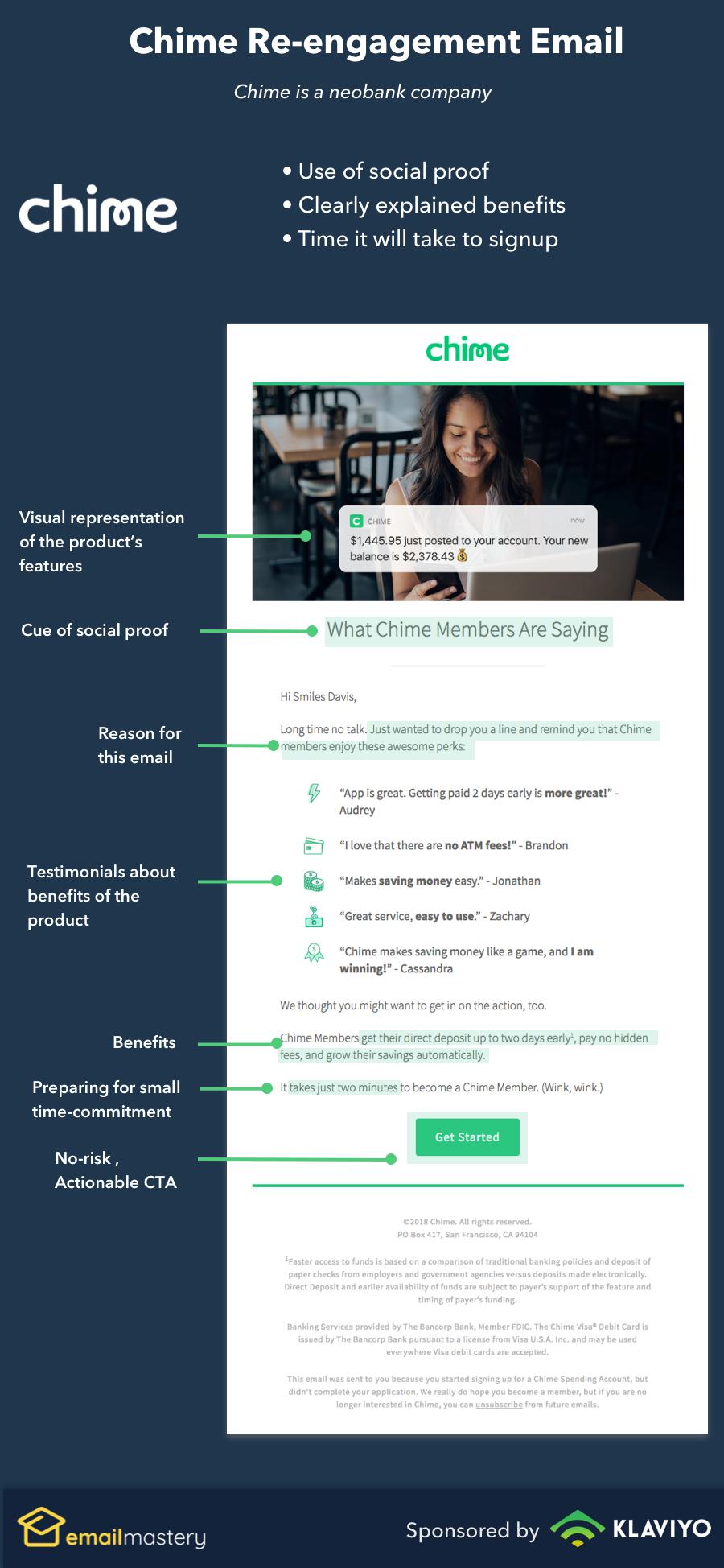Looking for email marketing tips to boost revenue and subscriber engagement?
Good call.
Many sources have touted email as the best marketing medium for building an audience, cultivating relationships with the masses, and even making sales.
2019 research suggests that email marketing has a staggering 42x ROI (for every $1 spent, marketers made $42). In another report by Statista, 49% of consumers said that they would like to receive promotional emails from their favorite brands every week. Finally, 80% of retail professionals claimed email as their most powerful channel for customer retention.
(Not to mention that email is the only platform where you have almost full control over what you send, when you send it, and who sees it… without trying to please some arbitrary gatekeeper — like the Facebook ad gremlins)
But as with all great opportunities, real results come from thoughtful execution.
And here are 11 email marketing tips to help you boost sales and brand engagement.
1. Write “Triggering” Subject Lines
Assuming that all other parts of your email are at least decent, the subject line is the most important element… especially when it comes to engaging new subscribers.
The subject line is the headline of your email — with a few exceptions, it should catch the subscriber’s attention and give them a glimpse of what’s inside.
We like to think of it this way; there are only really three reasons that people decide to open an email (three “triggers”, as we call them)…
Self-interest, emotional interest, and relational interest.
When a new subscriber joins your list, for at least the first few emails, they’re probably not going to open because of relational interest — they’re still deciding whether they trust you or not.
That leaves you the option of creating self-interest or emotional-interest with your onboarding subject lines, which you can see examples of above.
(It’s also a good idea to use these types of subject lines when trying to re-engage dormant subscribers)
But remember that the ultimate goal is relational interest — to get people opening because they trust you and they enjoy your emails… regardless of the subject line.
The only way to do that is to provide real value to your subscribers and to fulfill the promises you make with your subject lines.
So while it can be helpful to trigger people to open with self-interest and emotional interest subject lines, don’t ever make a promise that you can’t deliver on… or you’ll hurt the long-term relationship.
To learn more about crafting great subject lines, check out our email subject line guide.
2. Master The Welcome Email
In 7 Welcome Email Dos (and Don’ts!) for Stellar Results, Campaign Monitor points out that “open rates for welcome emails are, on average, 50%. This means that, compared to standard newsletters, they are 86% more effective.”
When you think about it, it’s not that surprising that welcome emails perform so much better than their future counterparts — this is when the subscriber is deciding whether or not they like your content and so they are more interested and engaged.
That’s why mastering the welcome email is so important.
In fact, there’s reason to believe that if people have meaningful engagement with your welcome email, they’ll be more likely to maintain a long-lasting relationship with your brand. Subscribers, for instance, who receive a welcome email show about 33% more engagement with the brand. And 74% of people are expecting to receive a welcome email.
Even if you’re not in it for the long-term relationship (which you should be), consider that welcome emails generate 320% more revenue than other promotional emails.
So the question, then, is how do you craft a welcome email that starts the relationship off on the right foot?
The good news is that this actually isn’t all that complicated.
Here’s the general flow we recommend…
Thank the subscriber — A quick “thanks for subscribing!” goes a long way.
Tell them what to expect — How often are you going to email them? What type of content are you going to send? Let them in on your plan from the get-go.
Give them a gift — Nothing says “we appreciate you” quite like giving the new subscriber something special. This could be a discount, a unique offer, or even an exclusive piece of content.
Here’s an example of this flow from Supergoop…

When in doubt, keep it simple.
Another “hack” you might consider if you’ve been emailing your audience for a while is this: look at your top 5 or top 10 emails by engagement (open rate and click-through rate). Then recycle one of those emails or mimic the flow and style of it for your welcome email.
Chances are if it worked in the past, it’ll work for your welcome email.
3. Build Curiosity With Preheaders
Now let’s talk about one of the most underutilized parts of an email campaign: the preheader.
It’s easy to assume that the preheader has almost no impact on the open rate of an email compared to the subject line.
But let’s not neglect the truth of human behavior: most of us, if the subject line piques our interest, will read the preheader snippet before opening.
If the preheader carries our interest forward then we’ll probably open.
So the preheader might not have as much impact as the subject line, but it certainly has an impact.
Better not to neglect it (especially since it’s such an easy thing to get right).
Here are a few tips for making your preheaders pop.
- Build Anticipation — Creating curiosity is a great way to improve open rate when crafting your subject lines and preheaders.
- Keep it Under 55 Characters — This is the ideal length for a preheader.
- Support the Subject Line — The preheader is important, but the subject line is still king. Your preheader should add to, not detract from, your subject line.
- Use the Hidden Preheader — This is a preheader that you can customize apart from the content of the email. We have the HTML code for doing this over here.
4. A/B Test a Percentage of Your List
How do you know that an email is going to perform before you send it?
Well, you don’t.
The only way to know whether an email is going to stand up to your expectations is by hitting send and watching the data roll in.
But for those of us who aren’t satisfied with playing games of chance, there’s a better way.
Start by brainstorming subject lines and select what you or your team thinks are the best two (note: you could do this same thing with CTAs and email content, but that’ll require a bit more work).
Then send the email to 20% (or some other statistically significant percentage) of your audience, A/B testing the two different subject lines with a 50/50 split. Once results come in (give it 24 hours), send the winner to the rest of your email list (the other 80%).
Morning Brew uses a similar process and it has helped them ensure that their open rate remains skyhigh:
“To start, we test our subject lines four ways every morning. Each of the four subject lines is sent to 3% segments of our audience at 5am. The winning subject line by measure of opens gets sent to the remaining 88% at 6am.”
5. Focus On The Relationship
Every month, about 600 people search for “email marketing tips” in Google.
And there’s nothing wrong with looking for ways to improve your email marketing strategy… as long as those tactics don’t damage your relationship with your subscribers.
You should, for instance, write more compelling subject lines, but you shouldn’t deceive your subscribers about what’s inside the email or rely on clickbait to boost open rate.
You should personalize emails in an authentic way (through segmentation and delivering real value), but you might want to shy away from inauthentic personalization (always including the person’s name when the email clearly isn’t exclusive to them).
While those tactics might increase open rate or click-through rate for a single email, they are ultimately short-sighted.
The real goal of email marketing is to build authentic relationships with your audience where they count on you to deliver value (whether that’s through free content, special discounts, or new and exciting products).
When your subscribers trust you to deliver value in every email, they engage because they trust you.
In fact, when we spoke with David Perell — podcaster, writer, and thought leader — he told us that his emails have a whopping 52% open rate.
(Campaign Monitor says an average open rate is between 15% and 25%)
But here’s what’s really telling about this: David Perell emails twice per week and he only ever uses two subject lines: “Monday Musings” and “Friday Finds”.

In other words, 52% of his subscribers aren’t opening because he has creative and compelling subject lines (even his preheader is usually just random text)… they’re opening because they trust him.
David’s subscribers know that he delivers real value in every email and so the subject line and preheader cease to matter.
The lesson?
Provide value in every email, allow people to easily adjust their preferences, segment subscribers by interest (more on that in tip 7), and you’ll be well on your way to building long-lasting (and profitable) relationships.
6. Re-Engage Dormant Subscribers
Every email list has dormant subscribers — people who’ve got in the habit of not opening the emails they receive… but who also haven’t unsubscribed.
This is a natural part of email marketing.
Some people will open almost every email you send, some people will open one email every month, and some people will stop opening altogether.
But here’s what you have to keep in mind: the line between engaged and unengaged isn’t all that thick.
It doesn’t take much for people to start engaging… or to stop engaging.
And it’s not just about your emails, either. Maybe someone starts engaging with your emails because you sent them something that they really loved… or maybe their budget for your products increased because of a job change and so they’re paying more attention. Maybe someone stopped engaging with your emails because you sent them something that they really didn’t like… or maybe they’re going through a busy season in their life and they don’t have as much time to engage with your emails.
The point here is, a subscriber’s lifetime journey is a moving target and not a straight line. People will flip-flop between engaged and unengaged for a plethora of different reasons.
That’s not a bad thing.
Your job is simply to define dormant subscribers for your list (a period of non-engagement that’s sufficient to assume the person is in a habit of not engaging with your emails; say, 90 or 180 days) and create a process for re-engaging those people — maybe that means emailing more, maybe less, or maybe it just means taking a different angle and sending different content.

Here’s our full guide to re-engaging dormant subscribers.
7. Personalize The Experience
Before we talk about email personalization, let us be clear about something.
We are not advocates for inauthentic personalization tactics… for trying to make it seem like you’re only emailing one person when you obviously aren’t.
Inauthentic personalization usually means including the name of the subscriber within the email (or subject line) and acting as though you’re only speaking to them.
To be clear, we’ve seen this style of email work… but it doesn’t work over the long-term because it’s personalized, it works because the emails are providing real value.
Look — your subscribers know that they’re not the only people on your email list. More importantly, they know it’s inauthentic and automated when you include their name in an email.
(This is why Neil Patel argues for the “de-personalization” of marketing in 2021)
Inauthentic personalization can be useful for increasing engagement in short spurts, but we wouldn’t rely on it for building long-term relationships with your subscribers.
The correct way to personalize the experience for your audience is by creating a savvy segmentation strategy… so that each of your subscribers only receives the emails that they want to receive.
Analyze subscriber behavior, allow people to set their preferences, and then build out segments on the back-end that allow you to engage with each sub-set of subscribers in a meaningful way.
To learn more about segmenting your email list, check out our complete guide over here.
8. Find The Mavens & Connectors
In The Tipping Point, Malcolm Gladwell talks about what it takes for ideas to spread. What he calls Mavens and Connectors are two critical ingredients of social epidemics.
Connectors are people who “know lots of people. They are the kinds of people who know everyone.” They are well connected and quite extraverted in expressing their opinions.
Mavens are marketplace experts who love to share their expertise with others; “The critical thing about Mavens, though, is that they aren’t passive collectors of information. It isn’t just that they are obsessed with how to get the best deals on a can of coffee. What sets them apart is that once they figure out how to get that deal, they want to tell you about it too.”
To differentiate these two, Malcolm Gladwell explains…
“A Connector might tell ten friends where to stay in Los Angeles, and half of them might take his advice. A Maven might tell five people where to stay in Los Angeles but make the case for the hotel so emphatically that all of them would take his advice. These are different personalities at work, acting for different reasons. But they both have the power to spark word-of-mouth epidemics.”
These groups of people have a uniquely powerful impact on the spreading of ideas.
Imagine if you could get these people to fall in love with your emails, your brand, and your products… How powerful would that be?
The first step is to identify the Mavens and Connectors who are on your email list. You might consider launching a referral campaign, looking at your top openers, or paying special attention to people who reply to your emails with comments and opinions or leave in-depth reviews of your products.
These are the people who care the most… the people who are going to help your email list grow via word-of-mouth.
Once you identify the Mavens and Connectors on your email list, it’s worth treating them with a little extra care — woo them by sending free branded swag, announcing them as one of your top subscribers, or giving them a special offer or discount.
9. Aim For Awe
Speaking of virality, research by Jonah Berger, the author of Contagious, indicates that a feeling of awe is the single most powerful emotion for inspiring people to share something online.
“Awe gets our hearts racing and our blood pumping. This increases our desire for emotional connection and drives us to share.”
But how does this apply to your email marketing strategy?
Well, you might consider trying to create a sense of awe with your emails — this could inspire people to forward the email or share its content on social media, both of which are good for brand awareness.
How can you inspire awe with your emails? Here are a few ideas…
- Run a high-value giveaway.
- Share new and exciting information with your audience.
- Offer a surprising discount.
You might not be able to give people a sense of awe with all of your emails, but it’s a good target to aim for, especially when you want your audience to share.
10. Create The Best Email Marketing Plan For Your Business
We’ve done deep-dive email marketing teardowns on brands like Nike, Huckberry, Headspace, Spotify, and more.
Studying those teardowns can certainly help you create an effective email marketing plan for your own business.
But here’s what you have to keep in mind: what worked for Nike or Headspace or Huckberry might not work for your business. Similarly, what works for you might not work for other businesses.
There are a lot of different factors to consider when creating your email marketing plan, such as the personality of your brand, the disposition of your audience, and the appeal of the products and services you offer.
The lesson here is, test different strategies, measure results, and keep doing what works for your business, regardless of what online experts (including us) are telling you to do.
At the end of the day, results matter most.
11. Newsletters For Long-Term Engagement
Most people are going to engage with your emails when they sign up, when they’re ready to buy, or shortly thereafter.
But with a weekly or monthly email newsletter, you can keep people engaged with your brand… even when they’re not buying.
Your newsletter might contain interesting facts, fun curated content, an internal peak behind the curtain of your business, or something else valuable to your audience.
You don’t even need to try and sell anything within this email. You can. But that’s not really the point. The point is to strengthen your relationship with your subscribers and provide them value so that they stay engaged.
Here’s an example from Everlane.

What’s YOUR email marketing tip?
Well, you’ve got a lot of email marketing tips from us in this article — write triggering subject lines, focus A/B test 20% of your list, and ultimately, focus on the relationship.
But what about you?
What email marketing tips have helped you create consistently successful campaigns?
discuss on twitter